The AMD Radeon RX 5500 XT Review, Feat. Sapphire Pulse: Navi For 1080p
by Ryan Smith on December 12, 2019 9:00 AM ESTSynthetics
While we’ve already had our an in-depth at Navi with the launch of the RX 5700 series earlier this year, new GPUs within the family sometimes expose bottlenecks that we haven’t seen before. So our synthetic tests can help to highlight these bottlenecks, as well as any other changes that the GPU designers may have made in the process of scaling down their GPUs.
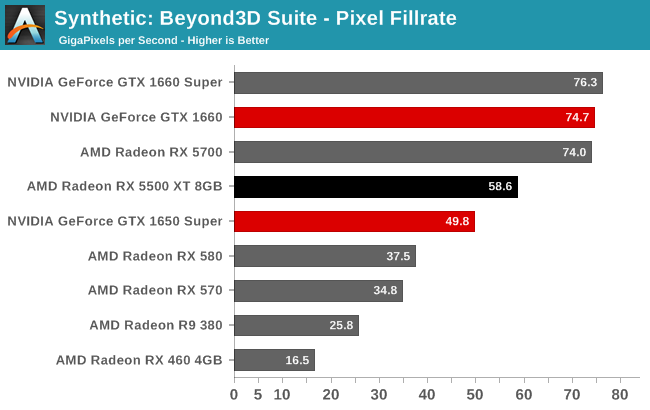
The RX 5500 XT does surprisingly well in our pixel fillrate benchmark. Even though it only has half the ROPs and half of the memory bandwidth of the more powerful RX 5700, it’s able to deliver ~79% of the pixel fillrate in this test. This is much better than I was expecting. It may be a sign that AMD’s ROP partitions aren’t seeing great scaling from 32 to 64 pixels per clock, or alternatively that AMD has made some significant efforts in keeping the RX 5500 XT from diving too hard due to its more limited resources.
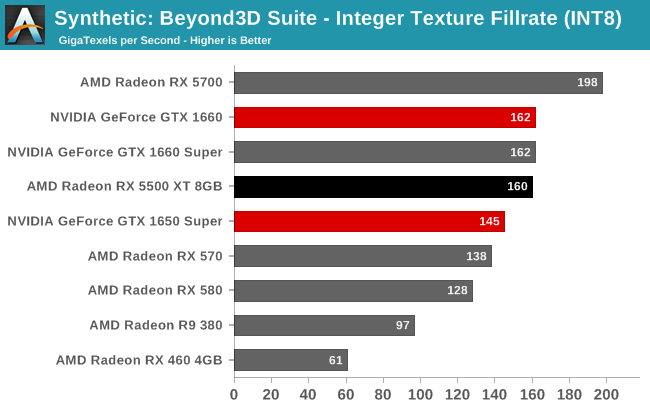
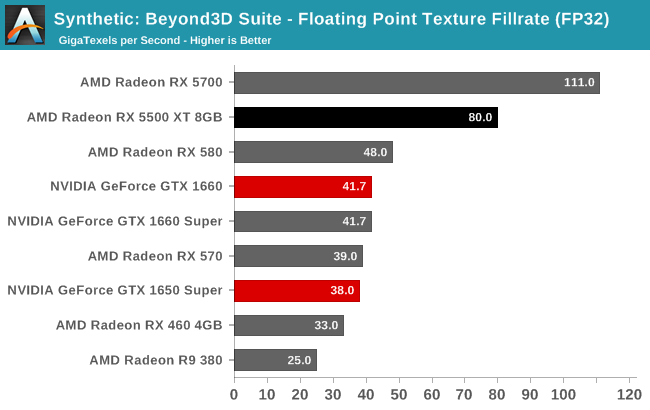
Meanwhile texture fillrates are more in line with our expectations. The RX 5500 XT has 14 fewer CUs than the RX 5700 but a slightly higher clockspeed, and its results reflect that.
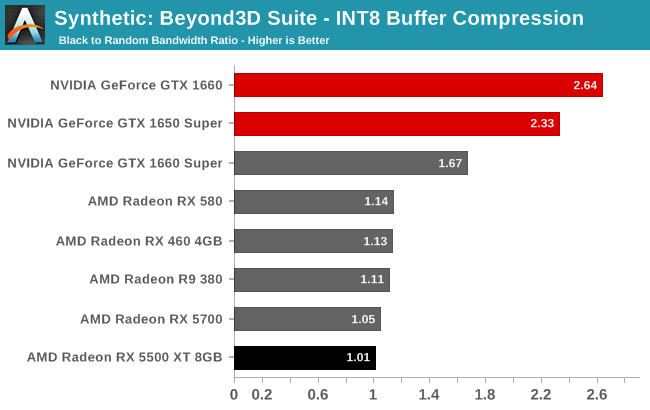

Our buffer compression ratios are also relatively consistent with what we’ve seen on the RX 5700 cards. AMD does have capable delta color compression technology; however it seems to struggle under intensive synthetic workloads. Under lighter workloads we see better compression ratios, but lower throughput overall.
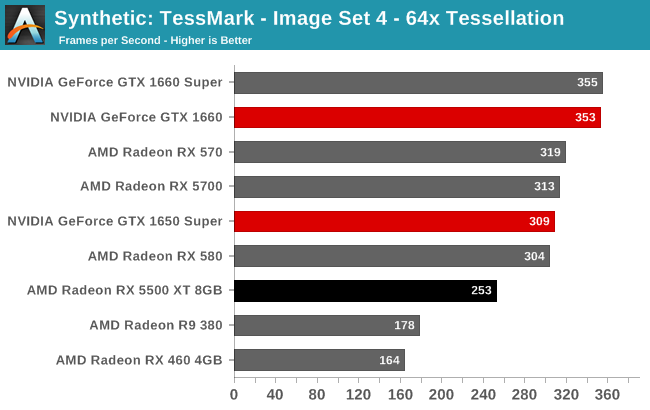










97 Comments
View All Comments
pcgpus - Friday, February 14, 2020 - link
Realy good comparasion of 5500XT and oponents is here:https://warmbit.blogspot.com/2020/01/rx5500xt-vs-g...
Smell This - Thursday, December 12, 2019 - link
{ snicker }
So ...
A cut-down GTX 1660 (TU116 - 284 mm2) with 6GB GDDR5 turns into a GTX 1650 (TU117 - 200 mm2) **Super** TU116 - 284 mm2 with 6GB GDDR6 ??
1) You've been "Played"; and
2) nVidia is going the wrong way.
Good luck with that.
silverblue - Thursday, December 12, 2019 - link
"Compared to AMD’s previous generation Polaris-based RX 500 series cards, the 1080p-focused RX 5500 XT delivers better performance""Competitive performance, meanwhile, is a bit of a trickier subject. As the replacements to the RX 570/580/590 within AMD’s stack, the RX 5500 XT almost always beats AMD’s older cards"
The elephant in the room here is the RX 590, at least in terms of gaming. In most titles, aside of those on page 6 as well as Total War in Ultra at 1080p, there doesn't appear to be enough of a gap between the 580 and 5500 XT to really set the latter apart. If we assume a somewhat standard RX 580 clocked at 1,340MHz/1,411MHz boost, the RX 590 could be 10% faster than this and would most likely beat the 5500 XT in a good number of cases. Additionally, Polaris looks like it has better 99 percentile performance.
drexnx - Thursday, December 12, 2019 - link
the 590 does look like it'll perform better, but it comes at a cost of about 100w more power - for some people this might not be an issue, for others it might be.PeachNCream - Thursday, December 12, 2019 - link
If you're building a new PC from scratch or have a lower wattage PSU in a system that is potentially getting an upgrade and the choise is between the RX 590 and the 5500 XT, the additional money spent on power delivery may tilt the cost versus benefit situation in favor of the 5500 XT. That 100W difference is significant enough to possibly cause that sort of problem.silverblue - Thursday, December 12, 2019 - link
Agreed with both of you.RSAUser - Friday, December 13, 2019 - link
Wattage isn't really an issue, a normal 450W will support the entire system. I'd still take the lower wattage part as less heat in the case so less fan spin.FreckledTrout - Friday, December 13, 2019 - link
A typical white box 300 watt PSU though and then you are left with one choice.HarryVoyager - Thursday, December 12, 2019 - link
Honestly, right now the real elephant are the used 580 8gb cards currently flooding the market. At $100, they're about equivalent to the 5500 XT, and have the 8Gb video memory the author is worried about. At this performance range, it's very hard to recommend someone spend 70-100+ more for pretty much the same real performance.The 5500 XT replaces the 580 at the low end, but doesn't really offer much that seems compelling over it.
I am hoping, however, that AMD can flesh out their competition next year with the Navi 2 cards. I'm seeing this as more of a Zen 1 launch. They're back in the game, and have a competitive foundation, and now they need to get it up to fighting trim.
Kangal - Friday, December 20, 2019 - link
Agreed.I'm excited about RDNA, but not completely sold on the new cards. I think the product lineup is what's most disappointing. For instance, if I wanted a Low Profile card, then I would have to go with Nvidia. If I wanted top performance, again Nvidia. And if I wanted mid-high segment, well Nvidia's New-Super range is quite competitive and then there's the older high-end Pascal cards. And if I wanted a low-mid segment, well now it's competing again with Nvidia's Super cards, older midrange Pascal cards, and now even older AMD Polaris cards.
The product line is very important, as well as marketing/sales, and these are both things that Nvidia absolutely gets right and dominates. After a decent 5 years, the new AMD is adapting, but they're not quite there yet. For instance, remember the launch of Pascal? Nvidia launched a high-end and a slight cut-down version, shortly after they released their mid-range version, then their low-power variants. After a year, they introduced their highest-end version, and make slight tweaks to improve the performance and efficiency of the entire product line. If AMD was able to imitate that, they would've released the RX 5800, and cut-down RX 5700. Then a month later it would be the RX 5600 and RX 5500. Then another month later it would be the RX 5400 (Low Profile) release. Then six months later all the cards would've gotten a slight refresh, maybe tag the "T" suffix at the end. And they would've also released the RX 5900T as their highest-end product.
So do NOT I see RDNA like Zen 1 at all, that was market disruptive, and it forced Intel to compete. Whilst Zen 1.1 put Intel on the backfoot. Eventually Zen 2 annihilated them. If anything, the RX 480 was Zen 1, it kept/forced Nvidia to be competitive with their GTX 1060 cards. The RX 5500XT is basically Zen 1.1, but it's still trying to keep up against Nvidia. For a Zen2-like scenario, AMD's next card needs to cost less, AND, perform much faster, AND, use less power.
I don't see that happening, as Nvidia improves their: architecture, drivers, ray-tracing, and moves unto the 7nm node. So when that happens, AMD is going to be on the backfoot again like they have been for a long time. For AMD to remain competitive they really need to release RDNA2 sooner rather than later, and have the entire product line ready to sell. Let's stay optimistic, and assume that is going to happen with more R&D thanks to the extra revenue AMD receives from: consoles, CPU, servers, and stock market : )